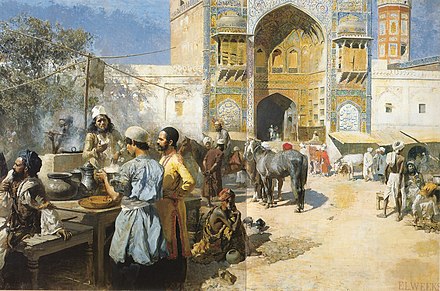Wazir Khan (Lahore)
| Wazir Khan | |
|---|---|
| Mughal Governor | |
.jpg/440px-PORTRAIT_OF_SHAYKH_'ALIM_AL-DIN_(WAZIR_KHAN).jpg) | |
| Governor of Lahore | |
| Reign | 1631–1641 |
| Governor of Agra | |
| Reign | 1628–1631 |
| Mughal Grand Vizier | |
| Reign | 1640–1642 |
| Born | Shaikh Ilam-ud-din Ansari c. 1560 Chiniot, Lahore Subah, Mughal Empire (present-day Punjab, Pakistan) |
| Died | 1642 Lahore, Lahore Subah, Mughal Empire (present-day Punjab, Pakistan) |
| Occupation | Governor |
Hakeem Shaikh Ilam-ud-din Ansari (died 1641),[1] known by his royal title Wazir Khan, was a Mughal administrator and an imperial minister who held the position of grand vizier in the Mughal Empire.
Career
Wazir Khan was born in a Punjabi family hailing from Chiniot in the present-day Jhang district, Punjab.[2][3] He rose to be one of the court physicians to the Mughal Emperor Shah Jahan in Lahore, and was in due course, over a long lifetime of service, made a Mughal noble with the command of 7000.[4] He remained Chief Qadi at Lahore for some time.[5]

From 1628 to 1631 he served as the governor of Agra after which he was appointed as the governor of Lahore. He held this post until approximately 1640/1641, when he was reappointed as governor of Agra.[1] In 1640, he became the Grand Vizier of the Mughal Empire[6] and remained so til his death in 1642.
Sikh Accounts
According to Sikh texts and tradition Wazir Khan was a supporter of the Sikh community and even a Sikh himself. Sikh tradition says he had been an admirer of Guru Arjan because of the parayer Sukhmani Sahib which is said to have given him relief. After which he had become a Sikh.[7] Thus when Guru Arjan was to be executed by the Mughal Emperor he did everything he could to save the Guru, but it was in vain. During the time of Guru Hargobind Wazir Khan kept his support of the Guru. When the Guru was arrested by the emperor Shah Jahan, Wazir Khan begged for the Guru's release.[8][9] After the first battle between the Sikh and the Mughals Khan convinced Shah Jahan that there wasn't value in taking further action against the Guru. He said, "Sire, the Guru is not a rebel and hath no design on thine empire. He hath ever been the support of the state... Is it not a mircale that with not fully seven hundred men he destroyed an army of seven thousand." Hearing this the emperor was convinced to take no further action against the Guru.[10]
Legacy
-
Wazir Khan of Lahore, known for building the Wazir Khan Masjid
-
Central dome of the Wazir Khan Hammam
-
The baths' cold chamber in the Wazir Khan Hammam is elaborately decorated with frescoes.
-
Garden of Wazir Khan, Agra artist, c. 1830
He is best known today for founding Wazirabad, a city near the river Chenab in Punjab, and building the famous Wazir Khan Mosque in Lahore. The title of 'Wazir Khan' by which he is remembered by posterity was granted him by Shah Jahan, and literally means a 'Wazir', or Vizier, a 'Minister/High Court Official'.
Alimuddin Wazir Khan was also responsible for the construction of the Shahi Hammam in Lahore, also known as the Wazir Khan Hammam.[11] Wazir Khan was also one of the nobles to build a Haveli(mansion) as well as a garden in the city of Agra, where he was twice governor.[12] It is known as the Bagh-i-Wazir Khan.[13]
References
- ^ a b Koch, Ebba; Barraud, Richard André (2006). The complete Taj Mahal : and the riverfront gardens of Agra. London: Thames & Hudson. p. 45. ISBN 978-0-500-34209-1. OCLC 69022179.
- ^ Talbot, Ian; Kamran, Tahir (15 February 2022). Colonial Lahore: A History of the City and Beyond. Oxford University Press. p. 30. ISBN 978-0-19-765594-8.
- ^ Ross, David (20 October 2017). The Land of the Five Rivers and Sindh: Sketches Historical and Descriptive (Classic Reprint). Fb&c Limited. ISBN 978-0-282-73696-5.
- ^ Syad Muhammad Latif (1892). Lahore: Its History, Architectural Remains and Antiquities: With an Account of Its Modern Institutions, Inhabitants, Their Trade, Customs, &c. from:Oxford University.
- ^ Dr A. M. K. Islahi (1997), Puranay Lahore Ki Tareekh, Eik Jaeza (in Urdu), Lahore: Chand Publishers Anarkali. p.128
- ^ ʻInāyat Khān (1990). Wayne Edison Begley; Ziyaud-Din A. Desai (eds.). The Shah Jahan Nama of 'Inayat Khan: An Abridged History of the Mughal Emperor Shah Jahan. Oxford University Press. p. 602. ISBN 978-0-19-562489-2 – via University of Michigan.
- ^ Macauliffe, Max (2015). The Sikh Religion Its Gurus, Sacred Writings And Authors Vol. 4. Creative Media Partners. p. 11. ISBN 978-0344857065.
- ^ Macauliffe, Max (2015). The Sikh Religion Its Gurus, Sacred Writings And Authors Vol.4. Creative Media Partners, LLC. p. 26. ISBN 978-0344857065.
- ^ The Life and Teachings of Guru Hargobind. Singh Brothera. pp. 21–27.
- ^ Macauliffe, Max (2015). The Sikh Religion Its Gurus, Sacred Writings And Authors Vol. 4. Creative Media Partners. p. 96. ISBN 978-0344857065.
- ^ "South Asian Studies". Journal of the Society for South Asian Studies (Incorporating the Society for Afghan Studies). 9–11. The Society: 16. 1993 – via University of Michigan.
- ^ André Raymond; Attilio Petruccioli; Renata Holod; Salma Khadra Jayyusi (2008). The City in the Islamic World:Part 1. Brill. p. 585. ISBN 978-9004162402.
- ^ André Raymond; Attilio Petruccioli; Renata Holod; Salma Khadra Jayyusi (30 June 2008). The City in the Islamic World (2 Vols.). Brill. p. 573. ISBN 9789047442653.


.jpg/440px-Shahi_Hammam_4_(WCLA).jpg)
